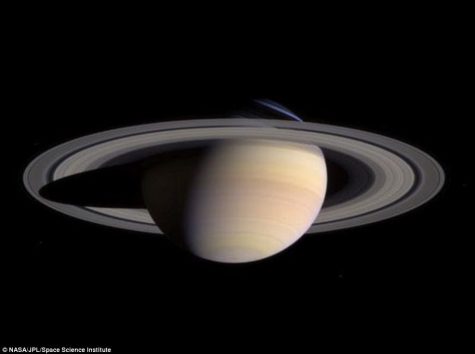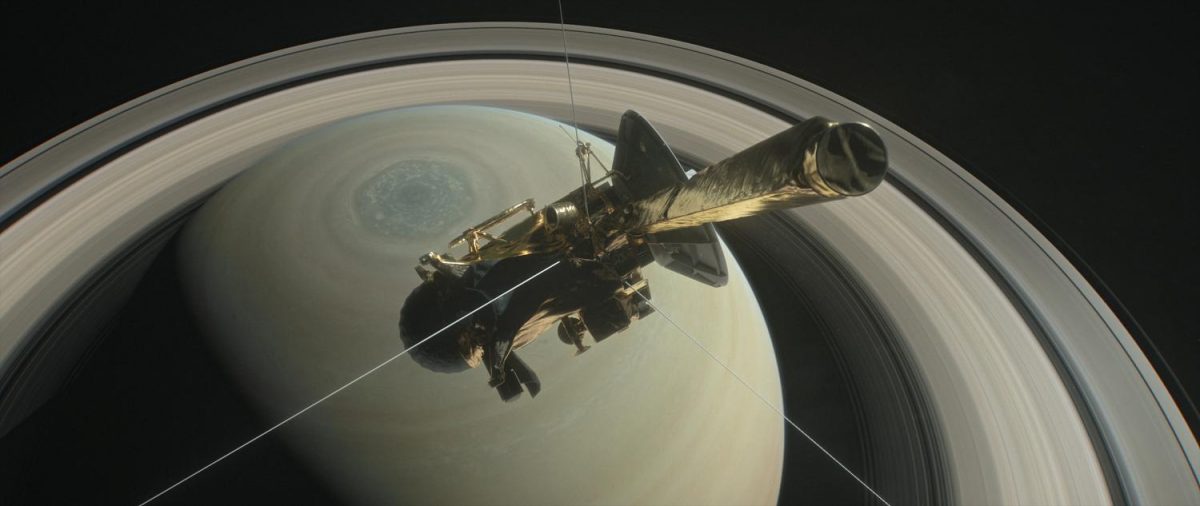NASA/JPL-Caltech
NASA’s Cassini pictured above Saturn’s Northern Hemisphere
Cassini’s Descent
Space...the final frontier...and final destination for Cassini
October 5, 2017
On Friday, September 15, the long voyaging spacecraft Cassini–Huygens trajectory was purposefully altered to crash into the dense atmosphere of gas giant Saturn after 13 plus years of sound scientific findings and research which help humans as a whole understand the celestial bodies which encompass us.
The Cassini probe was built as a collaborative effort between the National Aeronautics and Space Administration (NASA), the Italian Space Agency (ASI), and European Space Agency (ESA), bringing space agencies together for one of the first times to create the longest lasting probes over Saturn and its 53 countable ‘moons’. The probe, along with Huygens, a data collector for Saturn’s moon of interest, Titan, launched together on October 15, 1997, and stuck together for a long and suspenseful journey through the cosmos for the first years of the mission.
Four other probes had been sent to collect data of Saturn, and though they did their job, people wanted more from the bright object in the night’s sky, and with the previously believed theory of Saturn’s moon Titan being able to hold ice and maybe even flowing water, astrophysicists and humanity alike needed to know more of the faraway planet. Once the mission became public, NASA said, “Cassini-Huygens is a NASA/ESA/ASI mission designed to explore the Saturn system, including its rings and moons, with a special focus on Titan.”

Photo of Saturn taken by Cassini
Finally, on July 1, 2004, seven years after the initial launch, Cassini was in orbit of Saturn, with operators waiting for the perfect opportunity to release Huygens into Titan’s thick atmosphere over six months later on January 14, 2005. Huygens had been a major group effort for funding, engineering, and figuring out how to go to a place that nobody knew anything about.
The engineering group had accounted for as many conditions and situations that could be conceived, from a liquid landing with a bulky atmosphere, to a solid rock landing and a thin atmosphere. One of the main fears was fuel conservation of the Cassini probe and after difficulty with Huygens probe telemetry, it was thought no data could be collected from Huygens.
After a six-minute delay, all correct data transmissions came through, and a few hours after atmospheric entry, touchdown on a solid, but cushy surface was detected. The Huygens probe was the first foreign body to land on the unknown terrain of Titan, an astonishing victory of the space alliances and for all of the human race.
Arguably an even greater accomplishment was made when the probe sensors couldn’t find water or ice, but Cassini had picked up signals of water-ice on Saturn’s sixth largest moon, Enceladus, the moon that would inevitably end Cassini’s mission for good.
Enceladus is one of Saturn’s moons, one that is now known to harbor water under an ice crust, spewing out geysers of the hot liquid into space, captured by Cassini. Though it would have been ideal to visit Enceladus, liquid water could potentially mean the building blocks of life, which we cannot interfere with via bacteria that could have still lived existed on Cassini.
During the exploration, pictures of moons, asteroids, Saturn’s rings, data about Saturn’s atmosphere, and conditions for life were all collected, adding to our still limited, but far more telling knowledge of Saturn and it’s neighboring bodies.
